The SeabeeGram, Volume 1, March 2021
The SeabeeGram, Volume 1, March 2021 [PDF version]
Museum News
As a public health precaution due to COVID-19, the U.S. Navy Seabee Museum has extended our closure until further notice. At this time, a reopening date has not been set.
Despite the closure, the museum is offering extensive online content available in its online reading room. Museum staff is available to assist you with Seabee-related historical questions or museum operations questions.
General museum operations questions contact: SeabeeMuseumVisitor@navy.mil
Historical/reference questions contact: SeabeeMuseumArchive@navy.mil
Information about donating historical material contact: SeabeeMuseumCollections@navy.mil
Director’s Welcome
Welcome to the first volume of the U.S. Navy Seabee Museum’s newsletter, “The SeabeeGram.” The purpose of this newsletter is to provide the Seabee community and other museum friends regular updates about what is happening at the museum and to increase awareness and celebrate the rich history of the U.S. Navy Seabees. This publication is the result of the Museum and the Seabee Historical Foundation, the Museum's chartered private sector partner, joining forces to tell the story of the Seabees, the Civil Engineer Corps and NAVFAC and their shared role in serving our nation.
The name SeabeeGram is not new or original. Many of the early Seabee units as well as the Seabee Enlisted Detail shop used this title to inform Seabees about events and items of interest. Since we are celebrating history, it is only fitting that we adopt it as well.
Each SeabeeGram will highlight one or two key events in Seabee history, usually on their milestone anniversary year. The main historical article will focus on more contemporary Seabee history dating from 1975 to present. The museum and the Seabee Historical Foundation are collaborating to identify historically significant events and capture the stories of Seabees who experienced them firsthand.
Additionally, we want this to be a product that you can contribute to. We will feature a segment at the end of every issue called “Seabee Corner.” We will ask a question and you can answer in 50 words or less. We will publish a select few answers in the next issue. We only ask that you respect the word limit and remember this is read by families so keep the language PG! You can also submit events that you would like to see featured in future issues. To give us time to do the necessary research, the request should come six months prior to the anniversary. You can also submit an article for an event that you participated in and want remembered.
In commemoration of the 30th anniversary of Operation Desert Shield/Desert Storm, this inaugural issue features an article written by CAPT Bill Rudich, CEC, USN (ret) who served in the Civil Engineer Corps from 1973 to 2004. During the first Gulf War, CAPT Rudich was the Operations Officer and Chief Staff Officer for the Provisional Command Element. CAPT Rudich’s position afforded him an operational birds eye perspective of what the Naval Construction Force accomplished in the Desert. Rudich’s article below provides a succinct yet detail rich narrative about the Seabees role in the First Gulf War and illustrates how their involvement impacted future operations.
On behalf of the U.S. Navy Seabee Museum staff, I hope you enjoy this first volume of “The SeabeeGram” and that you learn a little something new about Seabee history.
Happy history hunting,
Lara Godbille, Ph.D.
Director, U.S. Navy Seabee Museum
Naval History and Heritage Command
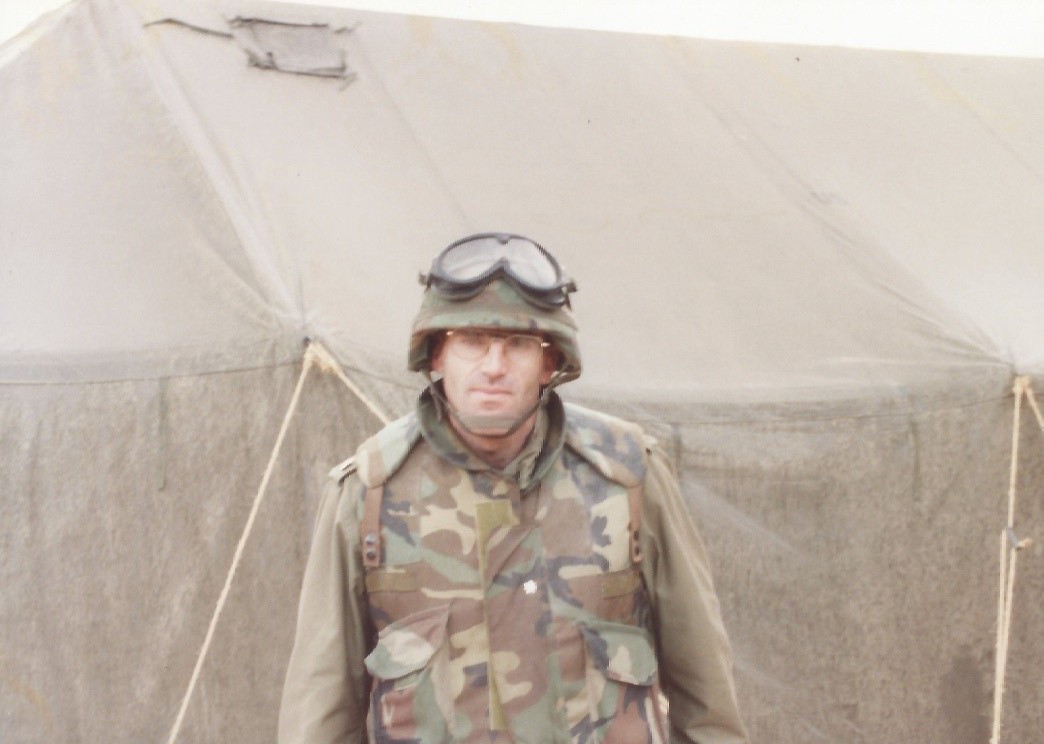
Seabees in Operation Desert Shield/Desert Storm by CAPT Bill Rudich, CEC, USN (ret)
On 2 August 1990, Iraqi forces invaded the Kingdom of Kuwait. Concern that the Iraqis would continue southward to capture the Saudi Arabian oilfields resulted in the deployment of US forces to Saudi Arabia starting on 7 August 1990. This operation would be the largest deployment/employment of Seabees since the Vietnam War and would reestablish the relationship with US Marine Corps which had faded since 1975.
The Seabee deployment began with Amphibious Construction Battalion (ACB) ONE which moved to the Port of Jubail, Saudi Arabia to unload Maritime Prepositioning Squadrons (MPSRON) TWO and THREE. In addition to unloading the ships which was accomplished in near record time due to the massive modern port facilities in Jubail, they installed the Amphibious Bulk Fuel System to pump fuel ashore. The shallow coastal waters increased the pumping distance beyond the capacity of a single system and required them to hook together two separate systems in series, something that the systems were not designed for. Later ACB TWO would deploy along with an Underwater Construction Team (UCT) in case the Off-shore Petroleum Distribution System (OPDS) was needed.
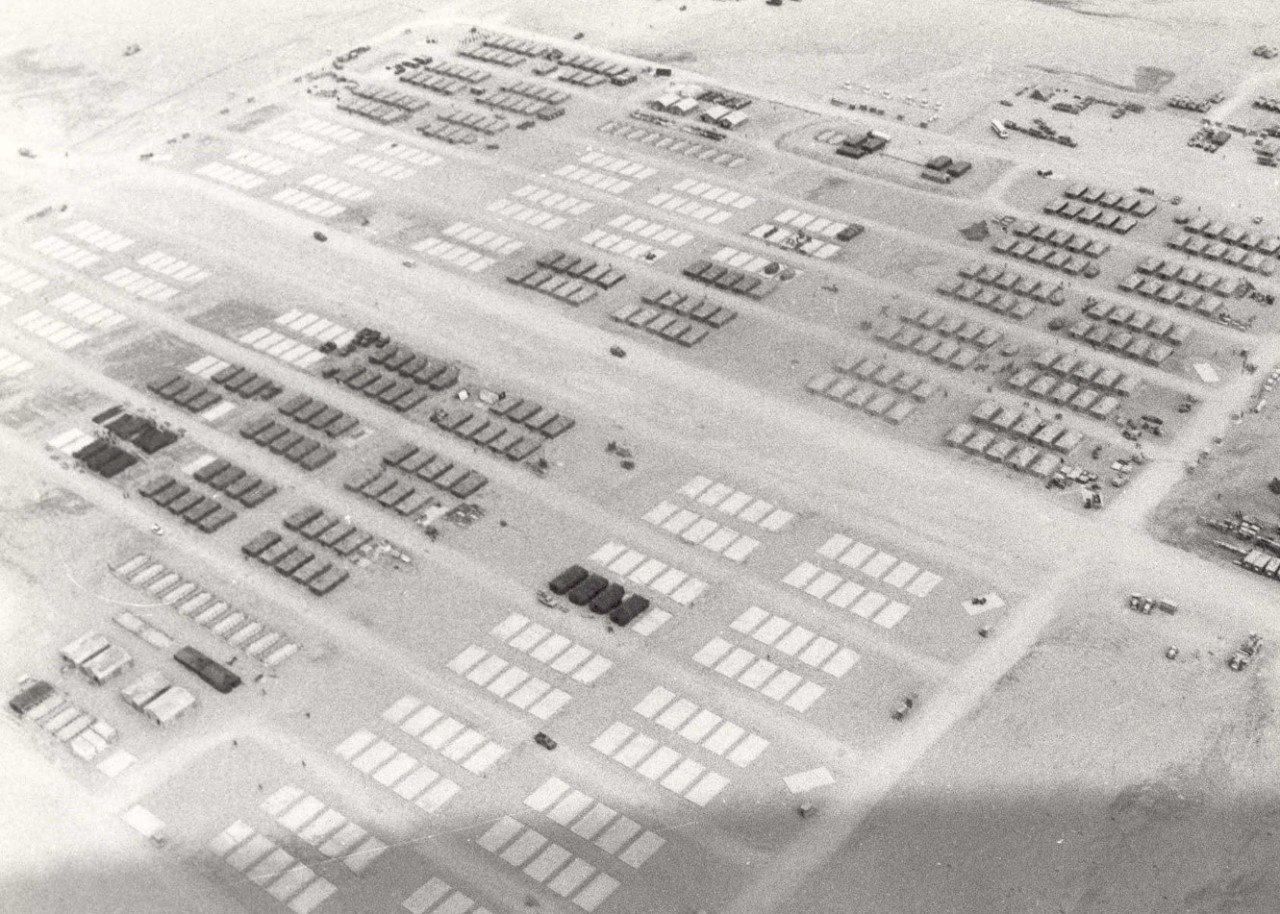
The initial employment for the Naval Mobile Construction Battalions (NMCB) based on a request for forces from FIRST Marine Expeditionary Force (I MEF) focused on expanding existing airfields. The runways at Jubail and King Abdul Aziz Saudi Arabia and Shaik Isa Bahrain were sufficient to support flight operations. What was not sufficient were parking areas which would have to bed down roughly 100 aircraft at each site while allowing sufficient clearance between them to avoid sympathetic explosions if one was hit during an attack. The final requirement was to bed down Marines throughout the Jubail area and to improve the port as needed to support operations. This estimated work would require four NMCBs to deploy the Central Command Theater. The battalions would be sourced from the forward deployment sites in Guam (NMCB 40), Okinawa (NMCB 7) and Roosevelt Roads (NMCB 4), Puerto Rico. The European Command would not release the Rota battalion so the decision was to deploy NMCB 5 which was half way through its homeport in Port Hueneme.
The command and control of the battalions in Theater was problematic as there were no active Naval Construction Regiments (NCR). A provisional command element, designated Commander Construction Battalions Pacific Forward Deployed (COMCBPAC FOXTROT DELTA) was formed with personnel from COMCBPAC, COMCBLANT and the 31st NCR. Then CAPT Mike Johnson, the 31st NCR CSO was assigned to command the operation.
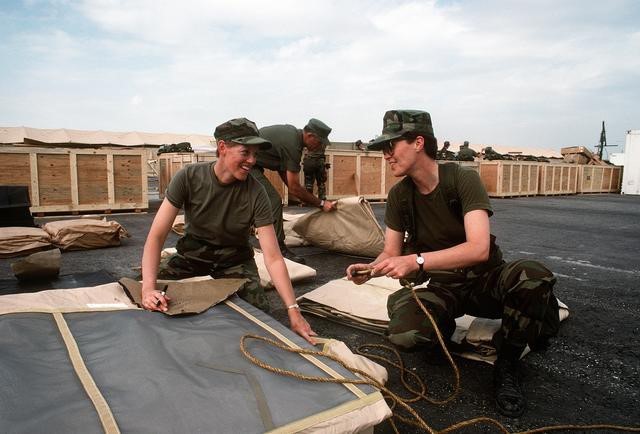
Deployment orders were issued on 7 August 1990. Initially Air Details were sent from each battalion. The demand for airlift was extensive which delayed the units’ arrival. The Air Det from NMCB 5 arrived in late August with others closing by mid-September 1990. Most of the battalions’ equipment was sent by ship with the final units arriving in mid-October 1990. NMCB 5 was stationed at Jubail Airfield, NMCB 7 at Shaik Isa and NMCB 40 and 4 shared a partially completed contractor camp in Jubail.
The Seabees immediately began work at the airfields with the second priority being the creation of hasty ammunition supply points (ASP) to store the Marines’ mountains of munitions. The various ASPs were several square kilometers in area and along with the airfield expansions required massive earth moving operations to complete them. The final part of the initial effort was to construct tent decks, burnout heads, shave stands and Southwest Asia huts for galleys and admin spaces to improve living conditions for the Marines at all locations.
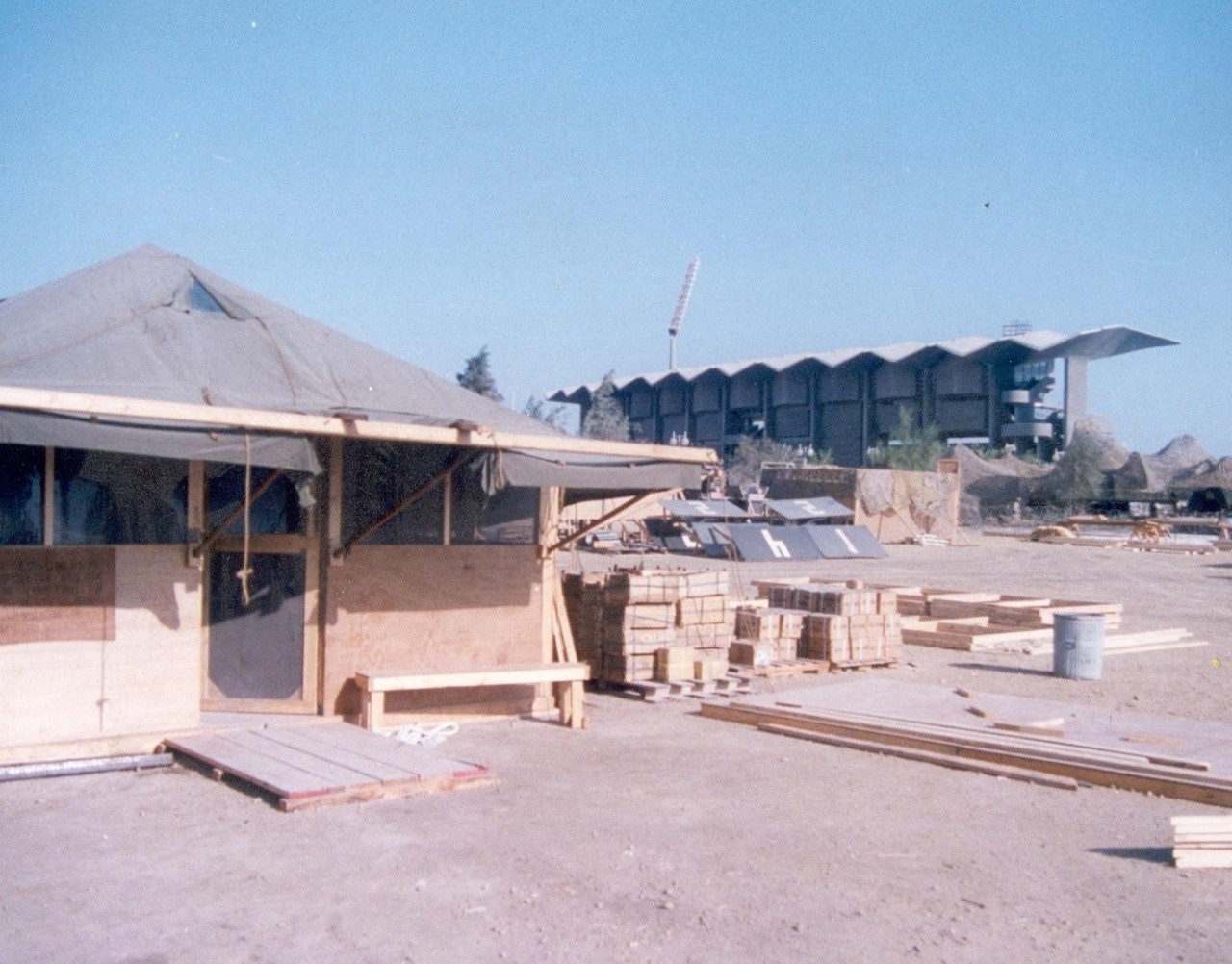
While the NMCBs completed their work, Construction Battalion Units (CBU) 411 and 415 from Little Creek and Norfolk deployed as the maintenance crew for Fleet Hospital FIVE. This was the first operational employment of a Fleet Hospital. Later in the operation, Fleet Hospitals FIFTEEN and SIX along with their assigned two CBHUs would also deploy.
The NMCBs had almost completed their initial tasking and there was talk of reducing Seabee presence when on 9 November 1990 President Bush announced the deployment of additional forces for an offensive to remove Iraqi forces from Kuwait. The additional Marines from II MEF would require similar bed down support for their troops, munitions, and aircraft. The Marines also planned to move forces further north towards the Kuwait-Saudi border. The initial tasking would be repeated and killed any talk of reducing numbers. However, the Seabees proceeded with their previous plan to rotate forces in accordance with the normal deployment plan. NMCB 7 would be relieved by NMCB 74 and NMCB 4 by a reserve battalion NMCB 24. NMCB 24’s mobilization to a combat zone was the first since the Vietnam War. The Command Element redesignated as 3 NCR rotated most of the staff and integrated personnel from CBPAC, CBLANT, 20th and 31st NCRs as well as the 3 NCR staff. Two large details from NMCB 1 in Rota were deployed to augment NMCBs 5 and 40 to bring them to wartime strength. The final NCF unit was NCFSU 4 which was brought into Theater to help manage the additional Seabee equipment that was deployed in case another battalion was needed and/or to replace potential war damaged items.
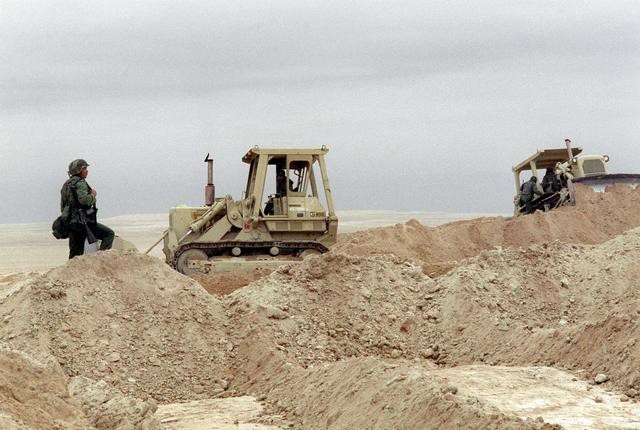
Work began immediately on the II MEF Camp (Wally World) a 15,000 person facility complete with tent decks, galleys, administrative huts and sanitary facilities. The required completion in less than 45 days necessitated that each battalion provide a detail to work on the project in support of NMCB 5 which was the lead. NMCB 5 also led construction of the Third Marine Air Wing (MAW) headquarters at Jubail airfield to allow them to relocate from Shaik Isa. The work adjacent to the Kuwaiti border included expanding the airfield at Mishab. To support this, NMCB 74 moved from Shaik Isa to Mishab. NMCB 5 moved north to Kibrit to construct the MEF Forward Command Post, ASPs, tent camp facilities and an EPW compound for up to 40,000 prisoners. NMCBs 5 and 40 maintained the barely improved dirt road from Mishab to Kibrit to ensure it was trafficable for the logistics trains moving north. A late change to the scheme of maneuver for the famous “Left Hook” shifted operations west to Al Qarrah necessitating construction of another MEF Command Post and two parallel gravel C-130 capable air strips that allowed logistics to be flown to the staging areas in preparation for combat operations.
One of the more unique tasks undertaken to support the change in the location of the attack, was support to Task Force Troy, an effort by the Marines to deceive the enemy. Working feverishly, they constructed 15 howitzer and 25 Abrams tank decoys in less than 48 hours. The Seabees and Marines emplaced the decoys under cover of darkness in the Marines’ former positions and when covered with camouflage netting were realistic enough that they drew fire from the Iraqi positions.
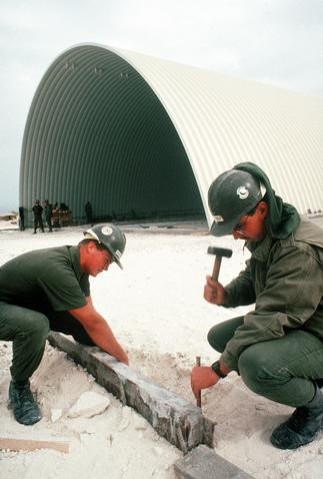
By the time the ground campaign began on 24 February 1991 the Seabees had completed multiple major projects and were poised to enter Kuwait if needed to build facilities for a potential Marine occupation. The rapid end to hostilities negated that requirement and that they would redeploy with all units completely out of Theater by the end of June 1991. Attached is a summary of their accomplishments.
Operation Desert Shield/Desert Storm resulted in many changes to the NCF. These included the establishment of an Interoperability Working Group with the Marines, the shift from the Utility Green uniform to the Woodland Camouflage, the replacement of commercial CESE with tactical vehicles, the eventual placement of Seabee equipment on MPSRON shipping and improvements to communications, weapons, and tactical equipment.
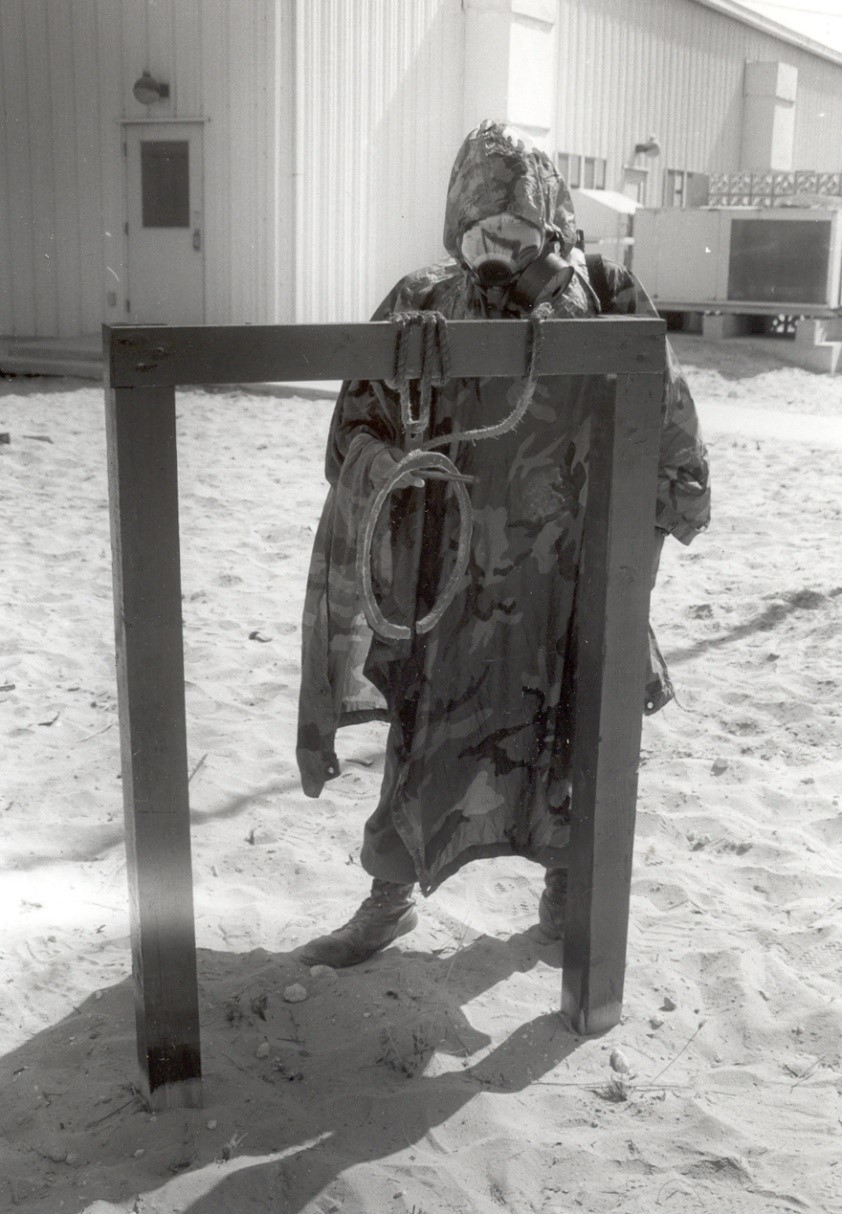
Naval Construction Force Production Statistics during Operation Desert Shield/Desert Storm
as of 1 February 1991
Camps: Total Capacity: 37,500 people
- 3,500 Jubail NAF
- 3,000 King Abdul Aziz
- 4,000 Shaikh Isa
- 4,000 Mishab
- 7,000 Jubail Port
- 15,000 II MEF Bed Down
- 1,000 3rd MAW Headquarters, Jubail
Enemy Prisoner of War Compound: 1 – 40,000 Man Capacity
Gallies: Total Feeding Capacity: 75,000 people
- 6 x 2500 man, 6 x 5000 man, 2 x 15000 man
Aircraft Parking: 6.0 million square feet of site prep and AM-2 Matting
- Jubail NAF: 915,000 sf
- King Abdul Aziz: 140,000 sf parking, 3900’ x 72’ taxiway, 2 x 150’ x 150’ VTOL pads
- Shaikh Isa:500,000 sf
- Tanajib: 400,000 sf
- Mishab Desert Location: 400,000 sf
- Moved 1.9 million cubic yards of fill to prepare sites
Hangars: 8 K-spans (15,000 sf each), 4 clamshell buildings (9,500 sf each)
Ammunition Supply Points: 4
- 9.7 million square yards total area
- 1.2 million cubic yards of fill moved
- Stored over $2 billion of ordnance
Medical Facilities: Total Bed Capacity: 2600
- Site Prep 2 Fleet Hospitals (1000 beds each)
- 1 Army Field Hospital (400 beds)
- 1 Aeromedical Evacuation Center (200 beds)
Road Maintenance: 150 miles of unpaved main supply routes/access roads
Buildings: 4,000 Strong Back Tents, 750 SWA Huts, 75 Guard Towers, 3,000 Tent Slabs
Miscellaneous Work
- Defensive Barriers: 2000 Steel Hedghogs/Tetrahedrons, 500 Concrete Tank Barriers
- Drilled 1 Water Well
- Installed 50+ Attack Warning Sirens
- Built 2 X MEF Command Centers (Rear and Forward)
Materials Used
- 7.5 Million board feet of Lumber
- 92,000 Sheets of Plywood
- 110,000 linear feet of PVC Pipe
- 1.4 Million feet (262 miles) of Electrical Wire
- 250,000 cubic yards of Select Fill
From the Collection
The U.S. Navy Seabee Museum has an extensive collection of battalion Deployment Completion Reports (DCR) and many have been digitized for easy public access.
To learn more about the Seabee experience in the First Gulf War, visit the museum’s online reading room and check out some of the Operation Desert Shield/Desert Storm Deployment Completion Reports.
Operation Desert Shield/Desert Storm Reports
NMCB 5 1990-1991 Deployment Completion Report
NMCB 7 1990-1991 Deploymet Completion Report
NMCB 24 1990-1991 Deployment Completion Report
NMCB 40 1990-1991 Deployment Completion Report
NMCB 74 1990-1991 Deployment Completion Report
NMCB 133 1990-1991 Deployment Completion Report
Seabee Corner
The question for this issue is: What was your favorite deployment site?
Tell us when it was and why in 50 words or less.
Representative responses will be published in the May issue. Please submit your submissions to SeabeeMuseum@navy.mil no later than Friday, April 9th.
Happy 79th Birthday Seabees!
Every year at this time the Seabee community pauses to remember the history of our Navy’s Civil Engineer Corps (CEC) and fighting Seabees; reflect upon their successes; and recommit themselves to build upon excellence as the nation’s foremost combat and engineering community. On March 2 the Civil Engineer Corps will celebrate its 154th anniversary; and on March 5 the Seabees celebrate their 79th birthday.
However, March 5th has not always been the Seabee birthday. For more information about how this date was selected, check out this Naval History Blog.
Connecting on Social Media
While the museum is closed, staff are increasing education activities and offerings on social media. Follow the museum on Facebook, Twitter, and Instagram for On This Day in Seabee History, interactive activities, insights into museum operations, and other fun information!
USNSM Website: https://www.history.navy.mil/seabeemuseum
USNSM Facebook: https://www.facebook.com/seabeemuseum
USNSM Instagram: https://www.instagram.com/usnavyseabeemuseum
USNSM WordPress: https://seabeemuseum.wordpress.com
USNSM YouTube: https://www.youtube.com/user/SeabeeMuseum
USNSM Twitter: https://twitter.com/SeabeeMuseum
Women’s History Month
The USNSM is proud to celebrate Women's History Month throughout the month of March. Follow the museum on Instagram and Facebook to learn more about the experience of women in the Seabees and the Civil Engineer Corps. The museum will be sharing the stories of current and retired women who have served in the Naval Construction Force.
If you are a female Seabee and are interested in sharing your story with the museum, please contact us at SeabeeMuseumVisitor@navy.mil.
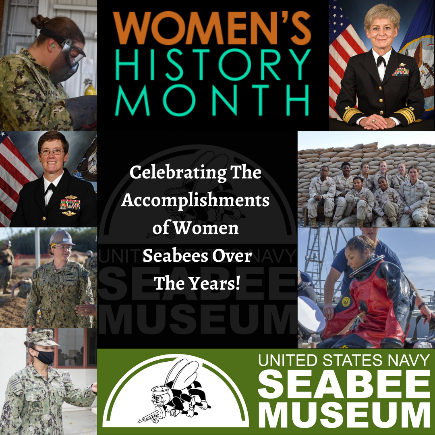
Seabee Historical Foundation
The SeabeeGram is published with support of the Seabee Historical Foundation (SHF). The SHF is the non-profit charitable partner of the U.S. Navy Seabee during Museum chartered to support the museum and its programs. For more information about the SHF, visit their website at www.seabeehf.org.


